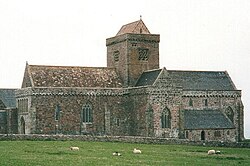Iona Abbey: Difference between revisions
m robot Adding: it:Abbazia di Iona |
|||
| Line 9: | Line 9: | ||
In [[563]] AD, [[Columba|Saint Columba]] came from [[Ireland]] to [[Iona]]. He founded a [[Monastery]] on this site. The [[abbey]] grew quickly and soon became one of the largest religious centres in western Europe. Monks from Iona set up religious centres as far away as [[Switzerland]]. |
In [[563]] AD, [[Columba|Saint Columba]] came from [[Ireland]] to [[Iona]]. He founded a [[Monastery]] on this site. The [[abbey]] grew quickly and soon became one of the largest religious centres in western Europe. Monks from Iona set up religious centres as far away as [[Switzerland]]. |
||
The world famous illuminated manuscript the [[Book of Kells]] was produced by the monks of Iona in the years leading up to [[800]] AD. |
|||
In [[806]] AD, everyone at the abbey was found dead. This has been attributed to a [[Viking]] massacre. Three other Viking attacks are recorded with eleven years of this date. |
In [[806]] AD, everyone at the abbey was found dead. This has been attributed to a [[Viking]] massacre. Three other Viking attacks are recorded with eleven years of this date. |
||
The Celtic Church remained separate from the [[Roman Catholic Church]] for many centuries. However, by the 13th Century, Iona had be absorbed into the Roman Church. It became part of the [[Benedictine]] order. |
The Celtic Church remained separate from the [[Roman Catholic Church]] for many centuries. However, by the 13th Century, Iona had be absorbed into the Roman Church. It became part of the [[Benedictine]] order. Black Nuns established their own abbey nearby in [[1203]] AD. |
||
With the onset of the [[Protestant Reformation]] in Scotland. Iona |
With the onset of the [[Protestant Reformation]] in Scotland. Iona along with other Scottish abbeys was destroyed. Many of the buildings were demolished and stone crosses destroyed. |
||
In the 19th Century, Iona was gifted to the [[Church of Scotland]]. Extensive restoration works were undertaken. |
In the 19th Century, Iona was gifted to the [[Church of Scotland]]. Extensive restoration works were undertaken. |
||
| Line 23: | Line 25: | ||
[[Image:Iona Abbey Celtic Cross.jpg|thumb|175px|left|St John's Cross in the Abbey museum.]] |
[[Image:Iona Abbey Celtic Cross.jpg|thumb|175px|left|St John's Cross in the Abbey museum.]] |
||
==Items of Interest== |
==Items of Interest== |
||
Revision as of 14:25, 2 August 2006


One of the oldest and most important religious centres in western Europe. Iona abbey is considered the point of origin for the spread of Christianity throughout Scotland.
Location
Iona Abbey is located on the Isle of Iona, just off the Isle of Mull on the West Coast of Scotland.
History
In 563 AD, Saint Columba came from Ireland to Iona. He founded a Monastery on this site. The abbey grew quickly and soon became one of the largest religious centres in western Europe. Monks from Iona set up religious centres as far away as Switzerland.
The world famous illuminated manuscript the Book of Kells was produced by the monks of Iona in the years leading up to 800 AD.
In 806 AD, everyone at the abbey was found dead. This has been attributed to a Viking massacre. Three other Viking attacks are recorded with eleven years of this date.
The Celtic Church remained separate from the Roman Catholic Church for many centuries. However, by the 13th Century, Iona had be absorbed into the Roman Church. It became part of the Benedictine order. Black Nuns established their own abbey nearby in 1203 AD.
With the onset of the Protestant Reformation in Scotland. Iona along with other Scottish abbeys was destroyed. Many of the buildings were demolished and stone crosses destroyed.
In the 19th Century, Iona was gifted to the Church of Scotland. Extensive restoration works were undertaken.
In 1938 the Reverend George MacLeod led a group which rebuilt the abbey, and founded the Iona Community. This ecumenical Christian community continues to use the site to this day.
The site was much loved by John Smith, Leader of the Labour Party. After his sudden death in 1994, he was buried on Iona.

Items of Interest
Many early Scottish kings and chiefs, as well as kings from Ireland, Norway and France are buried in the Abbey graveyard. (There are thought to be 48 kings there.) These include Duncan - the victim of Macbeth. The more recent grave of John Smith can also be seen.
Several Celtic Crosses are to be found on the Isle of Iona. St Martin's Cross (dated to the 8th Century) still stands by the road side. A replica of St John's Cross is found by the doorway of the Abbey. The restored original is located in the Infirmary Museum at the rear of the abbey.
The contemporary Jedburgh-based sculptor Christopher Hall worked for many years on carvings on the cloisters of the abbey, which represent birds, flora and fauna native to the island. More recently Hall was responsible for carving John Smith's gravestone.
External links
- Template:Historic-scotland-link
- Iona Community site with more background on recent history of the Abbey [1]
- School of Iona Catholic Encyclopedia article
